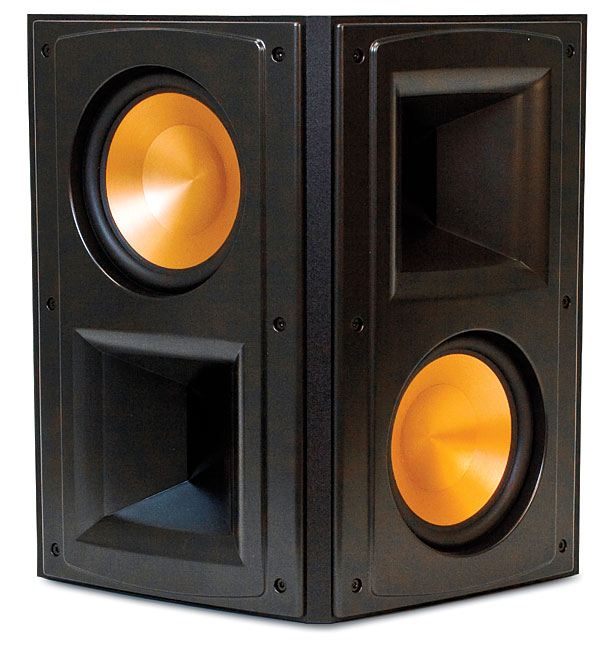Klipsch Reference RB-61 II Speaker System Page 2
The Island is another unfortunate victim of Warner’s policy of using old-school Dolby Digital on a Blu-ray Disc, which could easily accommodate a lossless or uncompressed PCM soundtrack. So the soundtrack was identical to the one I’d heard in the DVD release a few years ago. But even a lossy soundtrack delivering a cheap synthesizer-dominated score can sound pleasing, and this one did, aided by my Rotel AVR’s conscientiously clean power output. The trajectories of surround effects were strong and specific.

A Profusion of Surround
A Scarcity of Miracles: A King Crimson Projekct by Jakszyk, Fripp, and Collins arrived in a rare but welcome form. The two-disc set included a DVD-Audio disc comprising MLP 5.1 lossless, MLP 2.0 lossless, DTS 5.1 lossy, and LPCM 2.0 uncompressed soundtracks. The other disc was a CD, which made for convenient ripping en route to one of my iPods. Having heard this album in both low-resolution two-channel form and high-resolution 5.1, I can attest that the latter utterly transformed the experience of listening to these half-dozen melancholic ballads and two instrumental improvs.
With years of experience in listening to surround mixes, I’ve come to group them into three categories: the proscenium mix, with performers and audience on either side of an invisible divide; the horseshoe mix, which allows the performers to creep closer to the audience at the sides (incidentally, this is my favorite kind), and the dreamscape mix, which acknowledges few if any boundaries in the use of the soundfield. The dreamscape approach is the riskiest: It can become annoying in a hurry. Yet in this instance, it worked.
While the rhythm section remained rooted in front, the guitar, guitar synthesizer, lead vocals, and choral vocals roved a bit, while the saxes remained most often in the surround channels. This isn’t an arrangement found in nature. Yet it established a soundfield with a logic and consistency of its own, allowing freedom of movement to the glassine forms of Jakko Jakszyk’s massed voices and Robert Fripp’s guitar synth, while I remained rooted to Klipsch’s horn-defined sweet spot. There was no place I’d rather be.
Putting aside my surround obsession, let me note that every instrument benefited from the interaction between high-resolution format and speakers. Tony Levin’s bass and Chapman stick got the tuneful treatment his instinctively melodic playing deserved, the impacts and pitches of Gavin Harrison’s drums were precise, and Mel Collins’ saxophones had the dynamic character of singing voices.

I went on to the Blu-ray and DTS-HD Master Audio release of the Nobel Prize Concert with violin soloist Joshua Bell and the Royal Stockholm Philharmonic led by Sakari Oramo. Does life get any better? I haven’t been to the Stockholms Konserthus, but this Accentus Media disc was as miraculous an evocation of top-notch concert-hall sound as anything I’ve heard. The string sound neatly side-stepped familiar dichotomies.
It was warm but not laid back, front-row but not in your face, with a vinyl-like feel—if you define vinyl-like as a Linn LP12 with all the mods and accessories playing a vintage RCA Living Stereo, Deutsche Grammophon, or Telefunken LP.
Gift, by Eliza Carthy and Norma Waterson, arrived on CD. I made my usual comparison between the stereo original and rechanneling in the Dolby Pro Logic II Music mode, and I detected a slight difference between the center and monitors. The center speaker playing in DPLII sounded brighter than the two monitors playing in stereo. The difference was slight but discernible, and I preferred to play the album in stereo, which did justice to a mother-daughter team with two of the best voices in the British folk revival. Waterson sounds, as usual, like finely aged velvet, while her daughter Carthy has moved from the crystalline purity of youth into the huskiness of middle age with no loss of control.
Looking over my Klipsch reviews from the past couple of decades, I recall a lot of products I respected and liked but none that I fell in love with. The Reference II is the first Klipsch product to tip over that subjective line. Not that the character of the original Reference has changed that much: The difference is subtle. But it’s real enough to turn this product into one that I could live with for a long time.
Let me repeat my warning that to get the best out of these highly revealing speakers, you’ll need low-distortion amplification that tends to the warm side. Like Klipsches in general, these speakers don’t need much power, but they do need clean power. You also have to be the kind of now old-fashioned listener who’s willing to live in the sweet spot.
But if you’re thinking of buying into the Klipsch philosophy, the Reference II is an excellent way to do it—and this is the right time to do it. Farewell, Fred and Judy Klipsch—and for your too rarely celebrated contributions to the audio industry, thank you.




























































